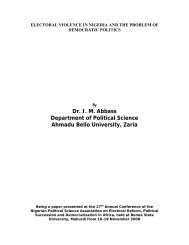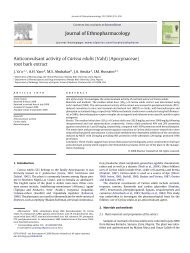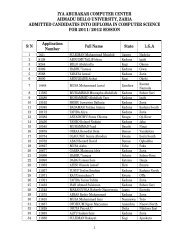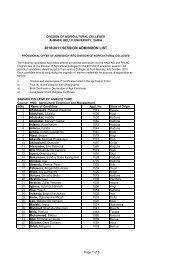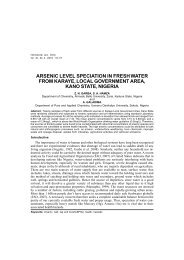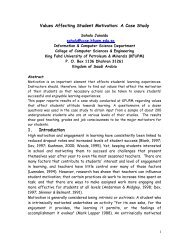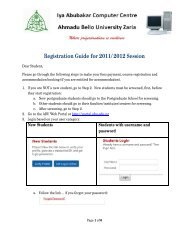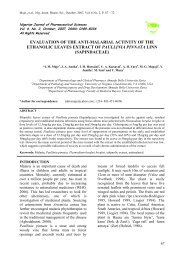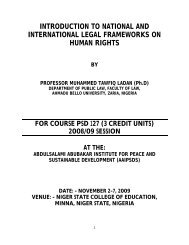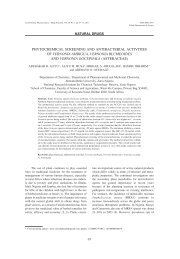Effects of N-Butanol Portion of Indigofera Pulchra - Ahmadu Bello ...
Effects of N-Butanol Portion of Indigofera Pulchra - Ahmadu Bello ...
Effects of N-Butanol Portion of Indigofera Pulchra - Ahmadu Bello ...
You also want an ePaper? Increase the reach of your titles
YUMPU automatically turns print PDFs into web optimized ePapers that Google loves.
<strong>Effects</strong> <strong>of</strong> N-<strong>Butanol</strong> <strong>Portion</strong> <strong>of</strong> Indig<strong>of</strong>era <strong>Pulchra</strong> Leaves Extract on<br />
Blood Glucose Levels <strong>of</strong> Alloxan-Induced Diabetic and Normoglycemic Wistar Rats 502<br />
Keywords: Indig<strong>of</strong>era pulchra, n-<strong>Butanol</strong>, Hypoglycemic activity, Normoglycemic,<br />
Alloxan, Diabetes mellitus.<br />
1. Introduction<br />
Diabetes mellitus is a chronic metabolic disorder <strong>of</strong> impaired carbohydrates, fat and protein<br />
metabolism. It is characterized by hyperglycaemia expressed as abnormal glucose value, which is due<br />
to insulin deficiency and/or insulin resistance which results in decrease utilization <strong>of</strong> carbohydrate and<br />
excessive glycogenolysis and gluconeogenesis from amino acid by fatty acids (Pontiroli et al., 1994). It<br />
has been defined by the World Health Organization (WHO) on the basis <strong>of</strong> laboratory findings as a<br />
fasting venous plasma glucose concentration greater than 7.3 mmol/L (140mg/dl) or greater than 11.1<br />
mmol/L (200mg/dl) two hours after carbohydrate meal or two hours after oral ingestion <strong>of</strong> the<br />
equivalent <strong>of</strong> 7.5g <strong>of</strong> glucose.<br />
This disease is on the increase all over the world, especially in Africa where it was formerly<br />
regarded as the disease <strong>of</strong> the affluent (Amos et al., 1997).<br />
Diabetes is one <strong>of</strong> the most common non-communicable diseases worldwide when compared<br />
with the general population, mortality and morbidity is increased in diabetes, due to the associated<br />
chronic complications – both specific microvascular retinopathy, nephropathy) and non-specific<br />
macrovascular artherosclerosis). Acute metabolic complications (e.g. diabetic ketoacidosis) continue to<br />
be a cause <strong>of</strong> mortality in developing countries (Ayesha et al., 2002).<br />
Using current and projected estimates, it has been suspected that the global prevalence <strong>of</strong> type I<br />
diabetes mellitus will increase from 3.5 million in 1995 to 5.5 million in 2010 (Amos et al., 2000). For<br />
Africa, the projected increase is from 85,000 (1995) to 219,000 (2010).<br />
Recent estimates indicate there were 171 million people in the world with diabetes in the year<br />
2000 and this is projected to increase to 366 million by 2030 (WHO, 2007). It is associated with<br />
reduced life expectancy, significant mortality and diminished quality <strong>of</strong> life. In 2005 an estimated 1.1<br />
million people died from diabetes. The American Diabetes Association (ADA) estimated the national<br />
costs <strong>of</strong> diabetes in the USA for 2002 to be US$132 billion, increasing to US$192 billion in 2020<br />
(WHO, 2007). If this is the case in a developed country, talk more <strong>of</strong> a developing country like Nigeria<br />
where 30% <strong>of</strong> people with diabetes live in low and middle income countries causing 5% <strong>of</strong> the deaths<br />
globally each year and likely to increase by more than 50% in the next 10 years without urgent action<br />
(WHO, 2006).<br />
Because <strong>of</strong> the tendency <strong>of</strong> many pr<strong>of</strong>essionals to cling to the belief that only pharmaceutical<br />
products are <strong>of</strong> value, therefore, possible source <strong>of</strong> new drugs to complement the action <strong>of</strong> oral<br />
hypoglycaemia agents. Renewed attention to alternative medicines and natural therapies has stimulated<br />
a new wave <strong>of</strong> research interest into traditional practice. The World Health Organization (WHO)<br />
Expert Committee on Diabetes listed as one <strong>of</strong> its recommendations; further investigations into<br />
traditional methods <strong>of</strong> treating diabetes (WHO, 1980).<br />
Indig<strong>of</strong>era pulchra(Willd) family: papilionaceae is an annual non climbing herbs or shrub that<br />
can grow up to 1m tall. It is widely distributed throughout west-Africa (Hepper,1976). In<br />
ethnomedicine, the leaves are used to treat infected wound (Hepper,1976;Burkhill, 1995) while the<br />
decoction <strong>of</strong> the aerial part is used as prophylactic against snake-bite (Sule et al.,2003) and as antiinflammatory<br />
(Abubakar et al.,2007). Previous pharmacological studies on the methanol extract <strong>of</strong> the<br />
aerial part <strong>of</strong> this plant showed that it exhibited venom detoxifying activities (Abubakar et al.,2006).<br />
The present study was designed to test the hypoglycemic effect <strong>of</strong> n-butanol portion <strong>of</strong><br />
Indig<strong>of</strong>era pulchra leaves extract <strong>of</strong> on alloxan – induced and normoglycemic Wistar rats diabetes.



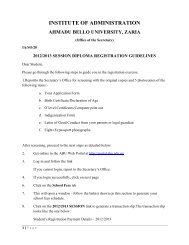
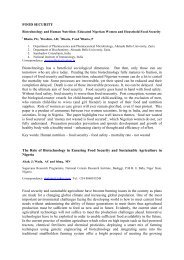
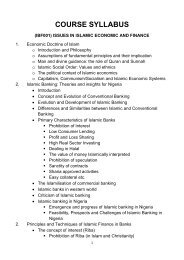
![Full Paper [PDF]](https://img.yumpu.com/49740055/1/184x260/full-paper-pdf.jpg?quality=85)
